ENGLAND
Economy

Economy
Cities in ENGLAND
| Birmingham | Liverpool | London |
| Manchester |
Popular destinations UNITED KINGDOM
| England | Northern ireland | Scotland |
| Wales |
Economy
General
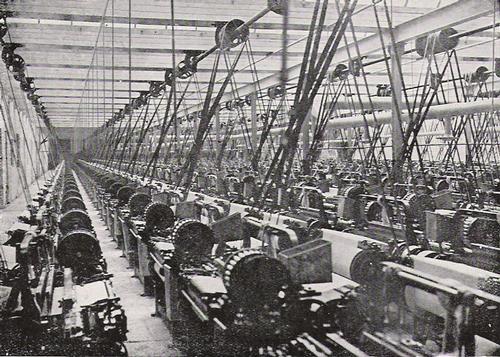 Steam engine-powered weaving mill in EnglandPhoto:public domain
Steam engine-powered weaving mill in EnglandPhoto:public domain
The Industrial Revolution in particular made the United Kingdom the first major industrial nation, making it the world's largest economic power. In the areas of trade, transport, industrial production and banking and insurance, there was an unprecedented boom. Around 1900, competition from the United States and certain European countries began to decline. After World War I, many industries proved obsolete and the United Kingdom gradually lost its predominant position. Added to this was the loss of most colonies after 1945, which narrowed the economic base. After the war years, the recovery with an economic growth of 2 to 3% per year (1945-1971) was slower than in most other Western European countries. Growth only increased to 2.3% per year between 1980 and 1986, to 3.8% in 1986-1987. After the Second World War, the Labor government started the nationalization of, among others, the coal mines, the iron and steel industry, the railways and some other transport companies and health care. State-owned enterprises employed 8% of the labor force in the late 1970s, accounting for 10% of national production and 14% of total investment. After 1980 these percentages dropped sharply as many sectors were privatized again by the conservative government of Margaret Thatcher.
In the early 1970s, the "oil crisis" triggered a severe recession, with high inflation of nearly 22% in 1976 and high unemployment. The 1980s were initially quite successful with rising GDP growth, a falling government deficit and falling inflation. At the end of the 1990s, the economic was 2.3%, but the trade balance became increasingly negative, as did the declining balance of payments surplus. Major oil finds and exports have prevented an even more marked decline in balances.
Currently (2017) approximately 16% of the labor force is employed in industry; over 83% are active in the services sector and only 1% are employed in agriculture.
The unemployment rate is lowest in the south of England, while unemployment is high in many old industrial areas and inner cities. On the positive side, the number of women in the workforce has increased by 10% since 1965, albeit often through part-time jobs.
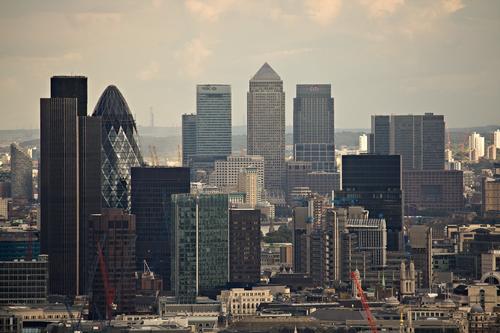 London Financial DistrictPhoto: Michael Duxbury(CC BY 2.0) no changes made
London Financial DistrictPhoto: Michael Duxbury(CC BY 2.0) no changes made
In 1998, the UK was only ranked fifth among the largest economic powers, and in terms of wealth per capita it was not even in the top twenty. Nevertheless, the country is of course still very important from a global economic point of view, with the capital London, for example, as one of the most important financial centers in the world. The government is fully aware that if the United Kingdom continues to play an important economic role in the 21st century, economic modernization is vital. Important matters in this are to keep up to date with the latest technological developments and to find alternatives to traditional forms of industry (e.g. mining and heavy industry).
Services have quickly become the most important economic sector and now (2017) already account for 80% of GDP. The two main sectors are banking and insurance, and the tourism, communications and information technology sectors are booming.
Industry accounted for 20% of GDP in 2017 (in particular the construction and production of goods and energy), agriculture only 0.7%. Economic growth is 1.7% (2017)
All the figures mentioned will be subject to fluctuations in the coming period depending on the course of Brexit (withdrawal from the EU) and how it has been handled.
Agricultural sector, forestry and fisheries
AGRICULTURE
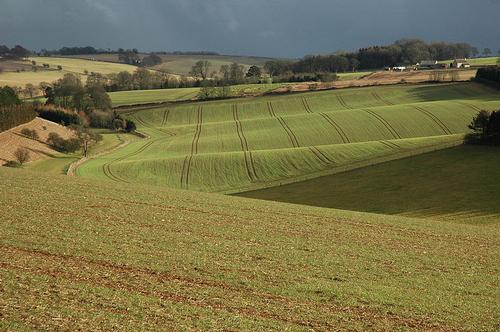 Farmland EnglandPhoto: Philip Halling CC 2.0 Generic no changes made
Farmland EnglandPhoto: Philip Halling CC 2.0 Generic no changes made
Agriculture occupies approximately 77% of the land area and accounts for approximately 70% of British food production.
The agricultural cultivated land comprises approx. 186,000 km2, of which approx. 64% consists of arable land, garden land, orchards and grasslands, so-called "improved land". The rest of the agricultural cultivated land is called "rough grazing", including poor natural pastures on mountain slopes and moors. Heather fields cover about 1/6 of the cultivated land in England. About 37% of the improved land is taken up by arable land (mainly grains, oats and barley).
Almost half of the farms are smaller than the minimum size required by the European Union for a professional farm. About 75% of farmers work full-time in agriculture. In total, approximately 550,000 people work in the agricultural sector.
Mechanization and research have contributed significantly to the intensification of British agriculture and horticulture. For example, between 1961 and 1981 the production of oats and potatoes increased by 63% respectively. 45%. Government policy has always been aimed at promoting mergers. Agriculture contributed 0.7% to the gross national product in 2017, while 1% of the labor force found work there.
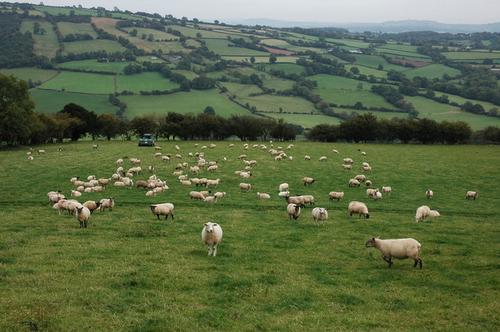 Sheep Farming EnglandPhoto: Philip HallingCC 2.0 Generic no changes made
Sheep Farming EnglandPhoto: Philip HallingCC 2.0 Generic no changes made
Livestock farming (especially in the west) occupies a dominant place in agricultural production. Slaughter cattle breeding is the most important; sheep farming is important for both meat and wool.
The area of horticultural land has decreased since World War II, but production has remained stable due to the strong intensification. Most horticulture is located in Kent and the West Midlands.
In 2000 incomes per farmer fell to the lowest level of the last 25 years. This agricultural crisis was partly caused by low prices and the growing food processing industry worldwide. The traditionally small English farms could no longer compete. Another cause was the outbreak of BSE or mad cow disease and foot-and-mouth disease (millions of animals were killed), which not only caused much damage to affected farmers but also affected confidence in English agricultural products in general. In recent years, agriculture has slowly recovered from all the blows it has endured. Organic farming is growing strongly.
FORESTRY
Only about 10% of the land area of Great Britain is covered with forest (2.8 million ha), and then special forest that is maintained and productive. About 50% of these forests are found in England, 40% in Scotland and the rest in Wales.
Nearly 45% of this forest is managed by the Forestry Commission, which is part of the government. The forest area is expanded annually, a quarter of which is commissioned by the government and three-quarters by order of private individuals. Most planting takes place in mountain areas, especially in Scotland (1998: almost 16,000 ha).
UK timber demand is covered only to a limited extent by domestic production; approx. 85% of all wood products are imported.
FISHERIES
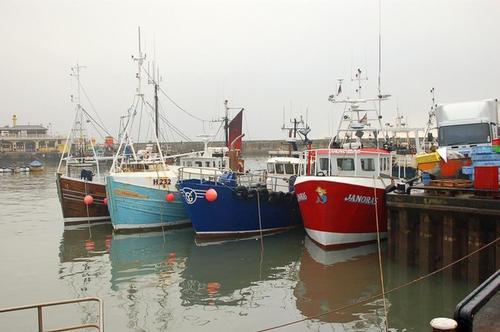 Fishing Boats EnglandPhoto: Gary Radford CC 2.0 Generic no changes made
Fishing Boats EnglandPhoto: Gary Radford CC 2.0 Generic no changes made
British fisheries lost much of their importance in the 1970s and 1980s, but still account for about two thirds of their national needs for fish and fish products.
The main English fishing ports are: Kingston upon Hull, Great Grimsby, Aberdeen, Fraserburgh in the Grampian Region, Peterhead, Lowestoft and Great Yarmouth.
Mining
Coal, petroleum and natural gas are the most important minerals. The main mining areas in England are those of Yorkshire-Derbyshire-Nottinghamshire and Durham-Northumberland.
In recent years, a large number of less profitable mines have been closed, and as a result, coal production has decreased tremendously. The main domestic customers for coal are the power plants.
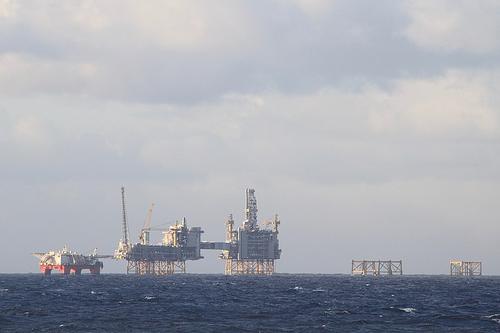 Oil Platform in the North Sea EnglandPhoto: NAC CC 4.0 International no changes made
Oil Platform in the North Sea EnglandPhoto: NAC CC 4.0 International no changes made
The oil fields on the British continental shelf in the North Sea are very important to the United Kingdom. Britain has been self-sufficient since 1980. British petroleum reserves are estimated at 4.8 billion tons. Oil extraction and processing is very capital intensive, which largely explains the large difference between the share of mining in employment (1%) and that in GDP (7.1%).
The North Sea has also supplied natural gas since 1962, which is operated by three subsidiaries of the state-owned British Gas. The gas reserves are likely to be sufficient for domestic consumption for the time being.
Minerals are also extracted: iron ore, sand, gravel, limestone, salt, slate and kaolin.
Industry
GENERAL
Despite the fact that Britain has lost its leading position in many industrial sectors, it is still a major producer of woolen goods (the oldest British staple industry), computers and other office equipment, telecommunications equipment, glass, iron and steel. The British Steel Corp. was remediated in the early 1980s and privatized in 1988. By closing old factories, introducing new technologies and reducing jobs, productivity could be considerably increased. Today, this company is the fourth largest steel producer worldwide, producing 85% of total British production. In shipbuilding, the production of off-shore resources was only able to partly halt the downturn. The most expanding sectors are the electronics, chemical and automotive industries. The aviation and aerospace industry is also important. Production ranges from civilian and military satellites to hovercraft. The British Aerospace Corp. is one of the largest aircraft manufacturers in the world. The chemical industry is in third place from a European perspective.
In Britain, industrial employment and production (as a percentage of GDP) have fallen significantly since 1966. Growth industries have settled mainly in the West London area, as well as, but to a lesser extent, in some Scottish cities. See also Northern Ireland, Scotland, Wales.
BIOTECHNOLOGY
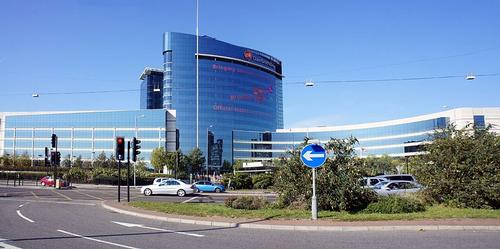 Headquarters of Pharmacy giant GlaxoSmithKline EnglandPhoto: Maxwell Hamilton CC 2.0 Generic no changes made
Headquarters of Pharmacy giant GlaxoSmithKline EnglandPhoto: Maxwell Hamilton CC 2.0 Generic no changes made
The United Kingdom is a leader in Europe in the field of biotechnology, in particular chemical, agricultural, pharmaceutical and environmental technology companies (approx. 550 companies, over 40,000 employees). The South East England (including Oxford) and East England (including Cambridge) regions are home to many life science companies.
ELECTRONICS INDUSTRY
The British electronics industry employs more than 400,000 people and turnover in this sector is increasing every year. The production of computers, office equipment, radio, television and communication equipment grew rapidly in the period 1990-2000.
The production of medical and optical instruments and electrical equipment decreased during the same period.
Most employment, especially administrative and sales functions, in this sector is in the South of England. The computer industry is the largest in Europe.
MACHINE AND METAL INDUSTRY
Approximately 300,000 people work in this sector, mainly in the Southeast, East and Midlands.
British companies are best known for their mechanical engineering, and mainly manufacture fuel engines, pumps, compressors, tractors, construction and earthmoving machines and textile machines.
These types of products are mainly purchased by national and international companies in the construction, aircraft, automotive and metalware industries.
The steel industry is mainly located in the south of Wales. A lot of post-processing takes place in Northern England, the Midlands and Yorkshire. The main company in this sector is Corus, the former British Steel and merged with the Dutch Hoogovens. Corus employs around 25,000 people in the UK, is the sixth largest steel producer in the world and the second largest producer in Europe. The vast majority of British steel production is processed in the construction and automotive world.
AUTOMOTIVE INDUSTRY
 Aston Martin DBS Superleggera EnglandPhoto: YLeclerc CC 4.0 International no changes made
Aston Martin DBS Superleggera EnglandPhoto: YLeclerc CC 4.0 International no changes made
The past two decades have seen tremendous growth in the British automotive industry. In 2002, around 1.8 million cars were produced in the UK, making it fourth in Europe. Sales in 2002 were £40 billion.
Major players such as Ford, General Motors, Toyota, Honda and Nissan make for one of the most competitive and dynamic automotive industries in the world.
Approx. one third of the total production comes from the West Midlands, where most car manufacturers and suppliers are located.
FOOD INDUSTRY
One of the largest sectors of the food industry is the market for bread and breakfast products. The sandwich market alone has a total value in excess of £3 billion.
Britons drink more than 2 liters of milk a week, making them one of the largest milk drinkers in the world. The UK dairy industry supplies almost 70% of the domestic cheese demand. More than 400 cheeses are produced in the UK, with cheddar being the most popular.
Beer and whiskey are traditionally the major alcoholic drinks in England, the production of which is important for employment.
Vineyards can be found in the southern half of England. Mainly white wine is produced. Apple and pear cider are mainly produced in the west and southwest of England. Bulmers, acquired in 2003 by Scottish & Newcastle brewery, is the largest cider producer in the world.
Clothing and fashion sector
The clothing and fashion sector is one of the main industries in the United Kingdom. Most clothing companies are located in the Midlands, North and East London and the North East. More than 200,000 people work in this sector.
The footwear industry is highly developed in Northamptonshire, Leicestershire, Somerset and Lancashire. In particular, many shoes are imported from Asia and other low-wage countries.
Trade
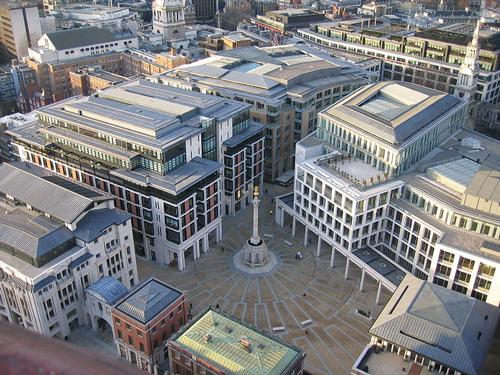 Londen Stock Exchange at Paternoster SquarePhoto: Gren in the public domain
Londen Stock Exchange at Paternoster SquarePhoto: Gren in the public domain
Britain is one of the most important trading nations in the world. The country exports many aviation products, motor vehicles, electrical appliances, chemicals, petroleum related products, tobacco and machinery. In particular, exports of raw materials grew strongly in the 1980s. Exports of services also increased. After the fall of the dollar, the United Kingdom is the world's largest net exporter of international services.
The relative decline in economic relations with the Commonwealth countries since the 1960s has been offset by an increase in trade with EU countries.
The UK has been facing a trade deficit for years. The causes of this shortage are the fall in the price of crude oil, an increase in imports and higher domestic demand.
In 2017, Germany, the United States, China, France, Ireland and the Netherlands were the main trading partners of the United Kingdom.
Banking sector
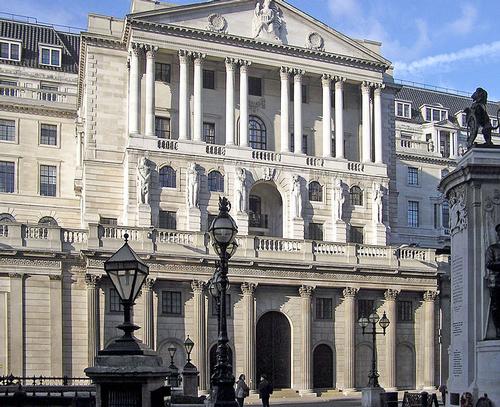 Bank of EnglandPhoto: Public domain
Bank of EnglandPhoto: Public domain
Nearly 500 foreign banks are located in the United Kingdom, mainly with a foreign clientele. London in particular, of course, has a large concentration of domestic and foreign banks. In fact, the insurance market is the largest in the world. The London stock exchange has the most listings after New York and Tokyo.
The central bank, the "Bank of England", was established in 1694. It handles domestic and foreign payment transactions, the issue and distribution of coins and banknotes. The Bank of England is also the house bank of the government. The banking sector will change as a result of Brexit.
Traffic
SHIPPING
The UK merchant fleet is losing global significance, with Britain and Northern Ireland counting more than 300 major and minor seaports. The main ports are: London, Liverpool, Manchester, Southampton, Newcastle-upon-Tyne. The main container port is Felixstowe. A very small part of the canals and rivers are used for commercial shipping.
AIR TRAFFIC
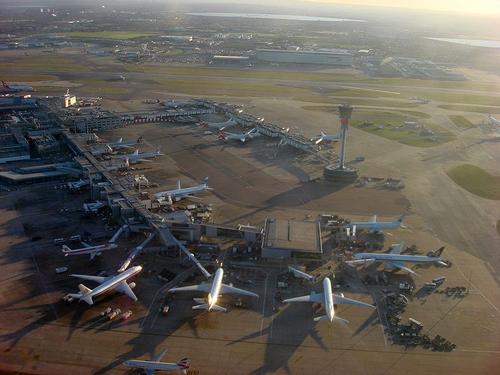 Heathrow Terminal 3 EnglandPhoto: Panhard CC 3.0 Unported no changes made
Heathrow Terminal 3 EnglandPhoto: Panhard CC 3.0 Unported no changes made
There are 21 major commercial airports, of which Heathrow (London) is by far the largest, with Gatwick coming in close.
Privatized in 1987, British Airways is the main airline and generates almost half of the UK airline industry's revenues.
RAILWAYS
British Railways were transformed into a state-owned company under the name British Railways in 1947. The length of the railway network is approximately 32,000 km. The railway tunnel under the Channel was commissioned in 1994.
ROAD TRANSPORT
In 2003, the road network consisted of 391,701 km, including main roads, which are entirely borne by the state, of which 3,000 km are motorways, 35,000 km are so-called principal roads, which are partly borne by the county in which they lie, and approx. 304,000 km other roads, which are the financial responsibility of the local authorities. Motorways were not started until 1955.
Road freight is very important for inland transport; approx. 80% of all goods are transported by truck.
Sources
Allport, A. / England
Chelsea House
Bowden, R. / Groot-Brittannië
Corona
Engeland, Wales
Lannoo
England
Lonely Planet
England
Rough Guides
Fuller, B. / Britain
Marshall Cavendish
Groot-Brittannië
Michelin Reisuitgaven
Locke, T. / Engeland
Van Reemst
Parsons, F.S. / Engeland
Van Reemst,
Schaedtler, K. / Highlights van Engeland en Wales
Gottmer
Somerville, C. / Groot-Brittannië
Kosmos-Z&K
CIA - World Factbook
BBC - Country Profiles
Last updated November 2025Copyright: Team The World of Info